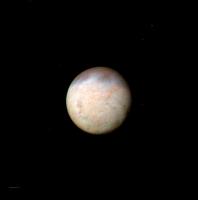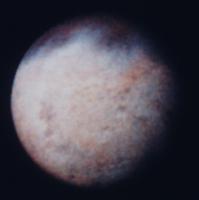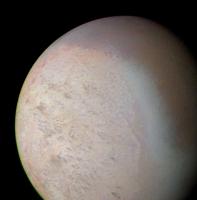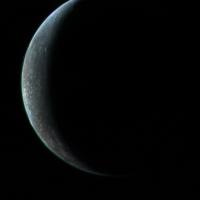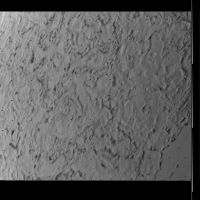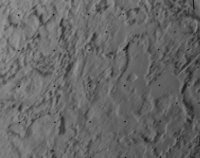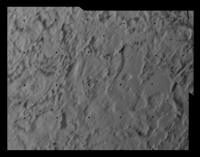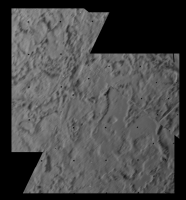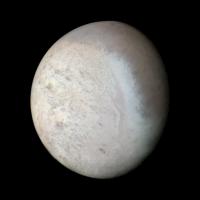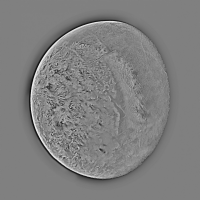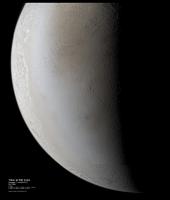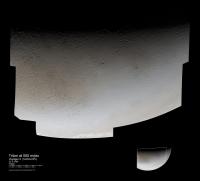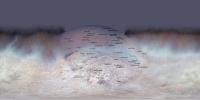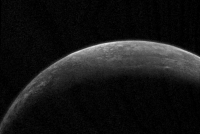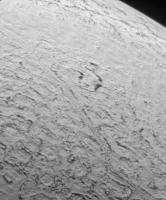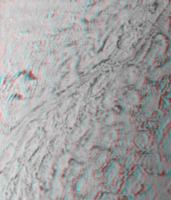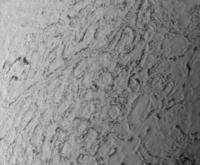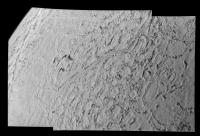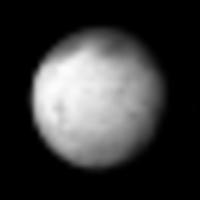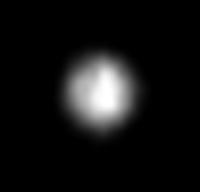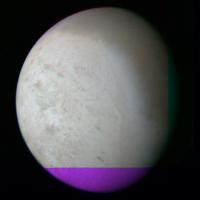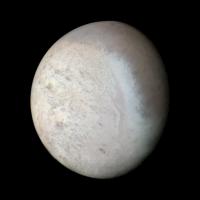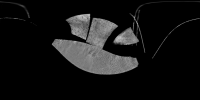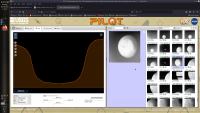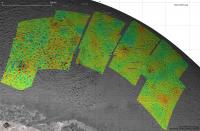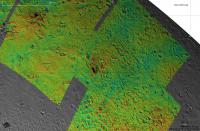Printable Version of Topic
Click here to view this topic in its original format
Unmanned Spaceflight.com _ Uranus and Neptune _ Voyager 2 imaging of Triton
Posted by: angel1801 Mar 7 2006, 04:15 PM
I was just wondering if someone has "super enhanced" the Voyager 2 images of Neptune's largest moon Triton and made them available to the public? I've read about and seen it done on Voyager images of Saturn's moons. Considering there won't be an orbiter going to Neptune being launched for a long time, this could be very worth while idea.
Posted by: tedstryk Mar 7 2006, 04:21 PM
I have been doing some work on Triton, slowly. Malmer had a really good Trition image as well. It is one of the best Voyager data sets in terms of coverage, but has some problems with smear and spacecraft motion.
Posted by: Decepticon Mar 7 2006, 11:26 PM
Here are some of my favs... global views
http://astrogeology.usgs.gov/Projects/BrowseTheSolarSystem/gifs/triton2.gif
http://nssdc.gsfc.nasa.gov/imgcat/hires/vg2_1138639.gif
And best of all
Posted by: Tayfun Öner Mar 8 2006, 09:31 AM
And best of all
Thanks Decepticon
Posted by: TritonAntares Mar 8 2006, 11:11 PM
http://astrogeology.usgs.gov/Projects/BrowseTheSolarSystem/gifs/triton2.gif
http://nssdc.gsfc.nasa.gov/imgcat/hires/vg2_1138639.gif
And best of all
Lovely...
Beautiful...
But were has this orange hue gone?
The orange, turquoise and violet colors were the most astonishing and impressive features,
when I first saw the images in 1989:
'Wow, so far away from sun and then these colors.'
Actually images from less distance didn't show them in this color strenght any more...
Why? False color imaging? What are the natural colors of Triton?
Bye.
Posted by: tedstryk Mar 9 2006, 02:41 AM
Looks to me like like it is a color balance issue. And, remember that since it is Voyager data, there is no red, so the color will be shifted with either Green or Orange substituted for red.
Posted by: machi Jan 10 2010, 05:32 PM
Result from cooperation with Ted Stryk. Triton animation from four Ted Stryk's processed images (from Voyager 2 WAC camera). Framerate is one frame per 2 seconds. Images are magnified 2x. Time from 1989-08-25T08:15:09.000 to 1989-08-25T08:39:09.000.
Download link is lower. Old animation with wrong colors was deleted.
Posted by: machi Jan 11 2010, 11:02 AM
Very nice images Stefan! Especially second one. One of the best Triton crescent images which I ever seen. But try remove color noise from image (speckles in image). Best way is perhaps manually removal. Than this image will be perfect.
I send improved version of Triton animation. Past version had wrong colors (problems with colorspace in encoder).
Posted by: Stefan Jan 11 2010, 03:49 PM
Thanks, perhaps I'll find time to improve it.
Another color composite:
Posted by: tedstryk Jan 11 2010, 06:39 PM
Excellent work animating this!
Posted by: Ian R Oct 16 2010, 01:30 AM
I've often wondered which Voyager picture Candy Hansen used in the following video to demonstrate how tectonic activity may have altered Triton's surface:
http://www.youtube.com/watch?v=yy2iscggebI
Well, I've found it -- it's a crop of image c1139623.png:
The cropped region:
In the video linked above, Ms. Hansen disects the image twice, moving the resultant pieces to reveal an ancient and degraded impact feature:
Cut One:
Cut Two:
Posted by: DrShank Oct 16 2010, 04:35 PM
i had forgotten about this idea long ago. interesting but the difficulty has been that any number of cuts and rearrangements can be made on this surface and none are truly unique or diagnostic. this terrain is not easy to work on but it is comprised of lots of adjacent closed and partly open circular features of similar size, a characteristic of diapirism (think salt domes or convection) not impact craters.
Posted by: Phil Stooke Oct 16 2010, 04:55 PM
I agree. It was an interesting idea, but different cuts and moves might create different apparent craters.
Phil
Posted by: tedstryk Oct 19 2010, 04:16 PM
I played around with it when I was working on the images for this post and noticed the fact that multiple alignments seemed to work. http://planetimages.blogspot.com/2009/08/more-triton-images.html
By the way, here is my version of the last set before Triton filled the frame:
And the high-pass version:
Posted by: machi May 27 2011, 05:16 PM
A long time ago, nearby a planet far far away ...
Triton hi-res mosaic from Voyager 2 spacecraft.
Color is from wide angle camera images (color from violet, green and synthetic image).
True resolution of images is between 0.7 to 1.05 km/pix (BW images) and 3.5 km/pix for color images.
One version is with backround WAC image and other is without it and rotated by 90 degrees (so south is approx. down).
Posted by: elakdawalla May 27 2011, 05:47 PM
Those are beautiful as usual, machi. Do you see any correlation between color and morphology?
Posted by: machi May 27 2011, 06:19 PM
Rather not. It looks that most of color differences are caused by deposits from atmosphere (brown-orange are methane ices? and bright blueish are nitrogen ices).
During processing, I found only one darker spot in rough terrain (cantaloupe? terrain), which can be directly matched with some type of morphologic unit.
Then bright ice deposits line the border of south polar ice cap and southern terrain is full of curvy units, which are more brownish (so presumably they contain more methane ices, geysers occurs in these regio). This terrain have not significant topography.
But more interesting terrain is near terminator. I see terrain which looks like hybrid between Martian and Europaean terrain. Some regions looks like chaos terrain on Mars, some even with glimpse of outflow.
Posted by: ugordan May 27 2011, 07:47 PM
Awesome work, these are keepers. Love the colors, too.
Posted by: john_s May 27 2011, 09:31 PM
I also love the colors- they ring truer, somehow, than other versions that I've seen. I also love the almost seamless blending of the NAC and WAC images. Nice job!
John
Posted by: tedstryk May 28 2011, 02:30 AM
Spectacular! Wow, I never thought of merging the WA images with the earlier high-res images. I just used it to place the highest resolution shots. http://planetimages.blogspot.com/2009/08/more-triton-images.html I reprojected them into earlier images http://planetimages.blogspot.com/2009/08/so-it-has-been-several-years-since-i.html
I am in awe.
Posted by: DrShank May 28 2011, 02:35 AM
i still wonder what the rest of Triton looks like . . .
Posted by: scalbers Feb 19 2012, 05:49 PM
Greetings,
Thought I'd post here an updated version of the feature overlays on my Triton map. I'll have to consider adjusting the color based on the above images.
Steve
Posted by: Stefan Feb 1 2014, 07:10 PM
I was inspired by http://www.planetary.org/blogs/guest-blogs/bill-dunford/through-a-glass-darkly.html...
Posted by: JohnVV Feb 2 2014, 12:57 AM
that is voy2 PDS image "c1140138.imq"
http://pds-imaging.jpl.nasa.gov/data/voyager/vg_0011/triton/
http://pds-imaging.jpl.nasa.gov/data/voyager/vg_0011/triton/c1140xxx/c1140138.imq
Posted by: Stefan Feb 2 2014, 01:37 PM
I am always fascinated by this image (C1139627), because it shows the surface of Triton as if you would see it from an airplane window. So far, I've only seen it stretched (for example http://photojournal.jpl.nasa.gov/jpeg/PIA00061.jpg). Here it is with the full dynamic range, so you can see the atmosphere and details in the dark terrain. I've also made a stereo image.
Posted by: john_s Feb 2 2014, 02:53 PM
Yes, it's a beauty! It's also rather poignant, because it's the last high-resolution, close-up, image taken in the entire Voyager mission. After that, all we had were ever-diminishing crescent views of Triton and Neptune.
John
Posted by: MarcF Feb 2 2014, 04:28 PM
I agree ! This is my favourite image of the Voyager 2 Neptune encounter. Flying over this frigid ice landscape... a dream ! It inspired me a lot to write my novels. It's a pity that we will not get again such images of Triton for a while. But I expect something similar with New Horizons about Pluto/Charon very soon...
Marc.
Posted by: Phil Stooke Feb 2 2014, 07:39 PM
You might like to look back at this thread as well.
Phil
http://www.unmannedspaceflight.com/index.php?showtopic=5921&pid=138447&st=0&#entry138447
Posted by: Doug M. Feb 3 2014, 10:31 AM
We're not seeing any better images of Triton for at least 20 years, right? No currently planned missions to Neptune by anyone, and (if my BOTE calculation is correct) even the Watt won't be able to approach Voyager's levels of resolution.
Truly, this outer planets work is a game for the patient.
Doug M.
Posted by: tedstryk Feb 3 2014, 10:38 AM
What is the WATT?
Posted by: centsworth_II Feb 3 2014, 01:41 PM
James Watt space telescope?
Posted by: MarcF Feb 3 2014, 01:45 PM
Do you mean James Webb space telescope ?
Posted by: centsworth_II Feb 3 2014, 02:09 PM
Woops! Don't worry mister Watt, some day they'll name something after you. ![]()
Posted by: tedstryk Feb 3 2014, 04:24 PM
The JWST is an infrared telescope. It won't have the spatial resolution to even match Hubble.
Posted by: JohnVV Feb 3 2014, 07:05 PM
so basically
it is reprocessing the old data with NEW software on new machines that have more than a 8086 and 32 meg ram
voy2isis, voycal, isis2raw( 32bit raw), adjust min/max and gama ( 0.6) , inpaint missing data ( "resynthesizer" )
http://imgbox.com/xQkfM9HU
gmic pde ( wavelet ) to smooth the noise
http://imgbox.com/kJUpDqhq
the straight imq to png , then the orig AFTER adjust min/max and gama
http://imgbox.com/sdySpxZ3 http://imgbox.com/Kr5eefxu
Posted by: dtolman Feb 4 2014, 01:40 AM
Hmmm... in the post Hubble era, will any scope be able to do high resolution observation of outer solar system objects with comparable or better resolution? Perhaps the Thity Meter Telescope or one of the other monsters being built on the ground? Or one of the donated NRO scopes?
Posted by: djellison Feb 4 2014, 01:44 AM
Pre or post Hubble....physics is physics.....the laws of optics still apply. The short answer is no. The long answer is in the physics described here : http://www.telescope-optics.net/telescope_resolution.htm
Posted by: dtolman Feb 4 2014, 01:48 AM
Sorry - wasn't clear. I wasn't asking if we could get Voyager level resolution, I already understood that was impossible - I was wondering what telescopes now or in planning for the next 10 years had _Hubble_ comparable resolution for outer-system objects.
Posted by: JohnVV Feb 4 2014, 02:42 AM
a BUNCH of new spacecraft will need to be sent out to the outer solar system
one for each planet and some for just the major moons
[ADMIN EDIT]
Posted by: Phil Stooke Feb 4 2014, 04:26 AM
Telescopes on the ground as good as Hubble - you bet. The advantage of Hubble being above the atmosphere has to a great degree been overcome with larger optics and adaptive optics on the ground. Look in this thread:
http://www.unmannedspaceflight.com/index.php?showtopic=6351&pid=193614&st=60&#entry193614
for examples of Uranus from Keck. Hubble can still compete in wavelengths that don't reach the ground.
Phil
(PS now I want to see Keck image Ceres!)
Posted by: Doug M. Feb 4 2014, 09:00 AM
Daaah, the Webb not the Watt. Excuse me.
A new generation of ground-based Extremely Large Telescopes will come online in the next decade. Both the Thirty Meter Telescope (Hawaii) and the European Extremely Large Telescope (Chile) are currently scheduled for first light in 2022. That's almost certainly optimistic -- but Magellan (Chile) is currently on schedule for first light in 2020. Ten years from now we should have two and maybe three ready to go. And all three of these things have apertures measured in tens of meters and surfaces measured in hundreds of square meters. (And price tags measured in eight or nine figures.)
How well they'd image a moon of Neptune is beyond my limited physics, though. Anyone?
Doug M.
Posted by: Stefan Feb 4 2014, 09:04 AM
Actually, there was one more! This one:
I used it as the "right eye" in my anaglyph. It is not as exciting as the other one, and also more blurry.
Posted by: Doug M. Feb 4 2014, 07:31 PM
Gorgeous. Makes you wonder if Pluto will have similar "cantelope" terrain? Some other sort of geologically active surface? Or just ancient craters on ice?
Whatever is there, we should (eventually, weeks and months after flyby) get good pictures of it -- NASA says that New Horizons will give us "images with resolution as high as 25 m/pixel, 4-color global dayside maps at 0.7 km/pixel, hyper-spectral near infrared maps at 7 km/pixel globally and 0.6 km/pixel for selected areas". The late Argo proposal for a mission to Neptune -- a flyby with a subsequent visit to a Kuiper Belt Object -- would have been basically New Horizon with a somewhat different instrument suite and 2010s technology. It would have flown as close as 200 km (!) to Triton, which would have allowed resolutions down in the tens-of-meters range.
Argo depended on a Jupiter-Saturn flyby, though -- a planetary alignment that will go away for a long time in 2020. So, probably not.
Doug M.
Posted by: john_s Feb 4 2014, 09:55 PM
Couple comments:
1) I thought the crisp horizon shot of the canteloupe terrain was taken after that blurrier overlapping image, but maybe I'm mis-remembering. I guess I'm biased in favor of the horizon shot, because it's sharper, but also because I wrote the original press release caption for it, back in 1989 ![]() .
.
2) I'm not sure where the 25 m/pixel number came from for the best New Horizons resolution on Pluto- the best resolution will actually be about 90 meters/pixel (much better than that best Voyager Triton image).
John
Posted by: Doug M. Feb 5 2014, 08:58 AM
John, that figure comes from http://nssdc.gsfc.nasa.gov/nmc/spacecraftDisplay.do?id=2006-001A&newwindow=true. The quote is from the 'Mission Profile' section:
"Flyby of Pluto will occur nominally on 14 July 2015. The encounter period begins 6 months prior to closest approach. Long range imaging will include 40 km mapping of Pluto and Charon 3.2 days out. This is half the rotation period of Pluto-Charon and will allow imaging of the side of both bodies which will be facing away from the spacecraft at closest approach. New Horizons will fly within 10000 km of Pluto at a relative velocity of 11 km/s at closest approach and will come as close as 27,000 km to Charon. During the flyby the instruments should be able to obtain images with resolution as high as 25 m/pixel, 4-color global dayside maps at 0.7 km/pixel, hyper-spectral near infrared maps at 7 km/pixel globally and 0.6 km/pixel for selected areas, characterization of the atmosphere, and radio science results. Because of the limited power available, the instruments will be duty cycled during encounter."
Doug M.
Posted by: Stefan Feb 5 2014, 10:59 AM
That's fascinating, John, you must have been so excited at the time! Do you remember what you wrote?
Posted by: tedstryk Feb 5 2014, 11:43 AM
John, is http://photojournal.jpl.nasa.gov/catalog/PIA00061 the original caption? I'm assuming it is referring to true resolution, as the resolution in km/pixel is better than that.
Posted by: john_s Feb 5 2014, 08:51 PM
Yes, and yes. I was a post-doc at the time, working with imaging team member Dave Morrison. I felt very lucky to be there- and even luckier to have also been at the Saturn and Uranus flybys, as a grad student.
That NSSDC quote is just plain wrong- the math doesn't work, given the resolution of the LORRI camera (5 microradians) and the stated encounter distance (10,000 km). Probably not worth fixing at this point, though…
John
Posted by: machi Feb 6 2014, 12:15 AM
As Phil already said, some telescopes are already better than HST in infrared. For now best images are from Keck II and Gemini.
Keck II is even comparable in absolute terms to HST, if atmospheric conditions are good. Best resolution is then around 0.03 arcsec.
This is equivalent to 4 resolution elements across Triton disc or ~650 km at Neptune distance.
HST has same resolution in wavelength near UV/visible border. New instrument - GPI on Gemini has similar resolution.
In near future (this year?) SPHERE will be available on VLT (ESO) with peak resolution around 0.02 arcsec (6 elements across Triton's disc).
A new generation of ground-based Extremely Large Telescopes will come online in the next decade. Both the Thirty Meter Telescope (Hawaii) and the European Extremely Large Telescope (Chile) are currently scheduled for first light in 2022. ...
How well they'd image a moon of Neptune is beyond my limited physics, though. Anyone?
Doug M.
TMT has planned resolution better than 0.01 arcsec with IRIS camera (0.008?). This is better than 200 km at Neptune and ~10-15 resolution elements for Triton disc at best.
E-ELT will be even better. It's exoplanetary imager EPICS has planned resolution up to 5 miliarcsec. With this resolution numbers are 110 km and 25 resolution elements for Triton.
But those are results for optimal conditions. Ground telescopes are dependent on good atmospheric conditions and powerful systems of adaptive optics. And adaptive optics needs for optimal operation bright point sources of light. Bright stars are best for this but such stars are available only for small areas of sky. Modern telescopes with adaptive optics are equipped with lasers which can produce artificial stars in atmosphere. With this lasers, telescopes are not so limited in their choice of targets on the sky, but results are always worse than in case with bright natural star.
This is example how Triton might look from E-ELT EPICS under optimal conditions and how it looks now from HST (FOC camera) (both images are magnified):
Posted by: MarcF Feb 6 2014, 09:20 PM
Even if there will be no mission to Neptune and Triton for a while, I think there might be still some discoveries to be made by using new image processing techniques of old Voyager pictures. I'm convinced that these images still hide some secrets. And we have some very talented people here. So keep going on processing them !
Best regards.
Marc.
Posted by: TheAnt Aug 22 2014, 02:23 PM
I have always thought Triton to be among the very most interesting moons. So all happy to find this new http://www.jpl.nasa.gov/news/news.php?release=2014-285 presented.
Posted by: scalbers Aug 22 2014, 06:18 PM
Yes, nice details can be seen on this map (from Dr. Shank). I wonder if the greenish cast in some areas would actually look that way to the human eye?
Posted by: MarcF Aug 22 2014, 07:27 PM
Paul Schenk is a magician to turn old pictures in new ones. I really dream about an Atlas of the Ice Giants Moons (Uranus and Neptune) like the Atlas of the Galilean satellites. Of course, there is not as much stuff as for the Galilean satellites and only their southern hemispheres have benn covered, but probably enough to do something great with processed Voyager 2 pictures.
Regards
Marc.
Posted by: TheAnt Aug 22 2014, 09:48 PM
I feel quite certain the colours of that map are enhanced, but it is ok since it help us see details - just like the crisscrossing bands of Europa would be hard to see without such processing. I expect that Triton would appear rather grey to the human eye, and that not just because of the fainter light at that distance from the Sun.
Posted by: ugordan Aug 23 2014, 04:19 PM
In my experience, calibration with Voyagers is an issue. Compared to Galileo and Cassini images of Jupiter and Saturn targets, it seems to me the relative filter brightnesses are off for all cameras. Green channel typically ends up being too bright compared to other filters which, along with the O/G/B filter combination, can lead to greenish results. A while back I attempted to use Saturn targets like Mimas, Enceladus, Dione and Iapetus to figure out better correction factors, with mixed results. Here's how a quick-n-dirty Triton O/G/B image turned out using those factors and also corrected for OGB -> sRGB filter wavelengths using linear interpolation:
Source images: C1138639, C1138651, C1138703
Posted by: tedstryk Aug 23 2014, 08:05 PM
This was my result with that dataset. I will say that not only is Voyager calibration an issue, but there was an entropy issue that seemed to get worse throughout the mission which made compensating for different exposure lengths difficult.
Posted by: DrShank Aug 23 2014, 09:26 PM
hi guys,
thanks for the nice words. more new maps in a few weeks! i also have the Triton high-res mosaic, which is almost done.
Ive updated the blog but wanted to point out that the map format is perfect for dropping into google earth or similar thing.
also the contrast is stretch a little bit but the color is not differentially enhanced. the contrast stretch brings out some of the color differences a little bit more. can't wait to put the pluto map next to it next year.
p
Posted by: DrShank Aug 23 2014, 09:34 PM
Source images: C1138639, C1138651, C1138703
that is interesting to hear. I wondered about that but we have no other reliable color data for Triton for comparison. perhaps you can send me some of your estimates for how far off the colors might be. in the meantime, i can look at some saturn data. a difficulty s that the cassini and voyager filters are not identical.
Posted by: Bjorn Jonsson Aug 24 2014, 05:03 PM
I have the same experience as Ted and Gordan, I always need to use various correction/fudge factors to get correct color when doing color composites from the Voyager images. As Gordan mentioned, the green channel is usually too bright. I usually use the calibrated and geometrically corrected images available at the PDS Planetary Rings Node but I get similar results if I start with the raw (*.IMQ) images and calibrate them myself.
I haven't done any systematic analysis to see if this problem varies as a function of time, exposure, gain etc. but I suspect that at least time (or mission phase) is significant. For many targets I can use the global spectrum to check the color but this is especially difficult for Triton since its color varies with time. For Neptune I can use its spectrum plus HST images to check the color and determine the correction factors - using the same processing parameters for Triton might work to get correct color.
Posted by: TheAnt Aug 25 2014, 12:17 PM
Oh hello there Dr Shank. =)
Yes I really would like to see a comparison between those two also to see if they show any signs of having a common origin.
I always have considered Triton to have been captured by Neptune even when the ejection hypothesis were the more popular one.
A little bit OT for this thread yet some expect Charon to show anhttp://www.nasa.gov/content/goddard/cracks-in-plutos-moon-could-indicate-it-once-had-an-underground-ocean/#.U_smzWN0bk8 as well I am a bit pessimistic about that idea, but then again our own moon have recently been found to have a http://www.nao.ac.jp/en/news/science/2014/20140807-rise.html despite the fact it got bound rotation so it might be best never to say never to tidal heating. =)
Posted by: Phil Stooke Aug 26 2014, 01:54 PM
Fantastic new map of Triton, Paul, thanks! It is nice to see the post-encounter crescent images incorporated into it.
Phil
Posted by: 4throck Aug 29 2014, 02:54 PM
Back at the time I was playing with Voyager images I also noticed that. My guess is that the filter's response changed with time. So it's dependent on mission time, craft and camera.
If there are any images of stars taken during the mission (I guess so) perhaps they can be used to infer calibration.
"White" satellites (if we have some spectra for them) would also work on distant images that show more than one (for different brightness), so that you could linearize the filters response.
Just my 2 cents...
Posted by: MarcF Aug 1 2018, 09:59 AM
Finally a "serious" geological map of Triton:
https://www.google.com/url?sa=i&rct=j&q=&esrc=s&source=images&cd=&ved=2ahUKEwjP_af9yMvcAhVExhoKHXNRAfgQjRx6BAgBEAQ&url=https%3A%2F%2Fwww.hou.usra.edu%2Fmeetings%2Fpgm2018%2Fpdf%2F7026.pdf&psig=AOvVaw1lXhvlOwJuLu2CnskqadIn&ust=1533200250600881
"To-date, no peer-reviewed, broad-scale, detailed geologic map exists to characterize, classify, and identify geologic surface units and features on Triton. Mapping of Pluto and Charon is in progress, but
as no comparable geologic map of Triton exists, a direct comparison between these two KBOs cannot be performed at a fundamental level. Furthermore, as Triton serves as a bridge between KBOs and icy satellites, characterization of its terrains is important for advancing comparative planetological studies."
Can't wait to see the final result. I expect some interesting discoveries, almost 30 years after the voyager II flyby.
Best regards,
Marc.
Posted by: MarcF Aug 6 2018, 05:14 PM
2018 paper with Voyager II Triton images:
Planetary and Space Science
Volume 160, 1 October 2018, Pages 19-25
https://www.sciencedirect.com/science/article/pii/S0032063317300557
Alvaro Martin-Herrero, Ignacio Romeo, JavierRuiz
New analysis of Voyager images reveals that the Raz fossae troughs system continues north of Leviathan patera and Cipango planum and enables to calculate that the surface heat flows values are much higher than those estimated in previous studies.
This troughs system reminds me the North-South global ridge/troughs sytem recently discovered on Pluto.
I'm convinced that some new great discoderies can be made by reprocessing the almost 30 years old Voyager images, even if a new mission to the Neptunian system is absolutely necessary.
Regards,
Marc.
Posted by: nprev Sep 2 2021, 02:12 AM
Resurrecting a dormant thread, there's a https://www.mdpi.com/2072-4292/13/17/3476?fbclid=IwAR0tmQCuTqXvVETzUqZRu4xxaPH6UEtqMh-kJ-27M7wY1oddL57QWh7Vz6Q out concerning Triton's topography. Prime author is Paul Schenk, coauthors include frequent Forum participant & NH PI Alan Stern and Forum moderator Ted Stryk, featuring Ted's image wizardry. Enjoy! ![]()
Posted by: climber Sep 2 2021, 07:28 AM
As a personal story, I was with TPS for Planetfest 89 at the time of Neptune’ flyby. We waited late to see the very first Triton’s pictures. When they came, around 4 am, I was already back in my hotel and discovered them on TV when I woke up. At that time, I was allowed to enter JPL’s reception and check TV screens and get a feeling of the place. We had scientist, no less than Ed Stone himself, giving the last news and picture at the TPS event.
You’re not only resurrecting a thread Nick, but also good memories. At that time, we hopped VII would survive for another 35 years, we’re close to it. Both Voyagers were launched the year I started working…and I retired 5 years ago.
Posted by: TrappistPlanets Sep 19 2021, 06:29 PM
SWEEET!
i think i can compile a DEM map out of some of the higher res figures
Posted by: TrappistPlanets Nov 7 2021, 02:49 PM
i increased brightness (messing with curves) , looking for neptuneshine, and i found this stuff beyond the terminator, is it atmospheric haze lit terrain , neptuneshine, or plain old noise?

i also seen it in the other pic too when i messed with curves

Posted by: Floyd Nov 7 2021, 04:23 PM
It is not clear to me what what areas you refer to as recovered in your posts. Maybe you could post three image, the original image unmodified, your clean modified image, and the area of interest (ie newly recovered area) circled or specifically delineated. The cloud of dots past the teminator in the image above seem to me to be noise, but maybe that is not the area you are describing.
Posted by: JRehling Nov 7 2021, 04:46 PM
By no means is doing this with images that someone has already processed for another purpose the best way to proceed. Whatever artifacts they may have introduced at very low values (0, 1, 2) is part of what you're trying to make something of now. There are multiple obvious artifacts and there's no accounting therefore for what is artifact and what isn't.
Never with work like this should you begin with an image that someone posted after performing undocumented processing to the original.
Posted by: TrappistPlanets Nov 7 2021, 07:24 PM
yeah, the cloud of dots beyond the teminator is what i am talking about, bummer its just noise
Posted by: TrappistPlanets Nov 7 2021, 07:30 PM
Never with work like this should you begin with an image that someone posted after performing undocumented processing to the original.
all the images on USGS PILOT are low resolution, and are full of jpeg artifacts, witch destroys any detail from potential neptuneshine or atmospheric haze lit terrain (same goes for PDS Image Atlas)
so where can i go to get original unprocessed images that doesn't have jpeg artifacts and is a good resolution
Posted by: mcaplinger Nov 7 2021, 07:38 PM
https://pds-imaging.jpl.nasa.gov/volumes/voyager.html has the raw images in PDS format.
Posted by: JRehling Nov 7 2021, 07:48 PM
This thread itself, if you go back to the beginning, is full of information useful to the topic at hand, including a link to:
http://www.unmannedspaceflight.com/index.php?showtopic=5921&pid=138447&st=0&#entry138447
which has more links to more information.
In general, this board is incredibly informative if you focus on the text as well as the images. Photoshopping the images you find is never going to be as informative as reading and following up on all of the discussion, which has already spoken to some of your questions. If you find something interesting in the nth post of a thread, consider reading posts #1- (n-1) in that thread.
Posted by: TrappistPlanets Nov 7 2021, 10:51 PM
where do i find the triton images though, and can gimp open that format, i use GIMP not PS
Posted by: djellison Nov 7 2021, 11:12 PM
You are going to have to do some of this work yourself. Google is your friend. The PDS is thoroughly documented. There are many tools available to process the products it has. The PDS has search tools.
http://bjj.mmedia.is/utils/img2png/ is what you will probably want to turn PDS published data into something GIMP can open.
Posted by: mcaplinger Nov 8 2021, 01:39 AM
Maybe in the triton subdirectories? The image names that when into the mosaics are shown at the bottom of the mosaics.
Honestly you have this a lot easier than I did in 1981 when I saw my first Voyager data on 6250 bpi magnetic tapes.
Posted by: JohnVV Nov 8 2021, 02:24 AM
use PILOT
it is a search tool
you will need to open the *.imq files ( voyager are NOT the default img files )
then remove the reasue dots
Posted by: TrappistPlanets Nov 9 2021, 11:55 AM
it is a search tool
you will need to open the *.imq files ( voyager are NOT the default img files )
then remove the reasue dots
how do i open the imq files in gimp?
Posted by: JohnVV Nov 9 2021, 02:40 PM
i think that " img2png" can open Voyager pds images
however i use ISIS4 on them
Posted by: TrappistPlanets Nov 9 2021, 09:51 PM
however i use ISIS4 on them
i am trying to find a 32 bit program of img2png, but i can't seem to find one, although google said "IMG2PNG is now a 64 bit program (earlier versions were 32 bit). This was a necessary change to make it possible to convert extremely large images, in particular 46080x23040 pixel LRO DEMs"
where can i find the previous versions that are 32 bit so i can try the program on triton
Posted by: Brian Swift Nov 10 2021, 12:34 AM
where can i find the previous versions that are 32 bit so i can try the program on triton
You could take a look at the old version from the Internet Archive
http://web.archive.org/web/20190430175504/http://bjj.mmedia.is/utils/img2png/
Posted by: kymani76 Jun 20 2022, 01:20 PM
Recently data from the article by https://www.mdpi.com/2072-4292/13/17/3476/htm became available https://repository.hou.usra.edu/handle/20.500.11753/1352.
I played around with stereo DEM data to create this maps, one showing the whole extent, the other close up of Kibu Patera area with contours. There are a lot of (sublimation?) holes visible in the terrain, that were not so obvious in photo only renderings.
I guess this elevation dataset is all that will be available for a very long time...
Powered by Invision Power Board (http://www.invisionboard.com)
© Invision Power Services (http://www.invisionpower.com)

